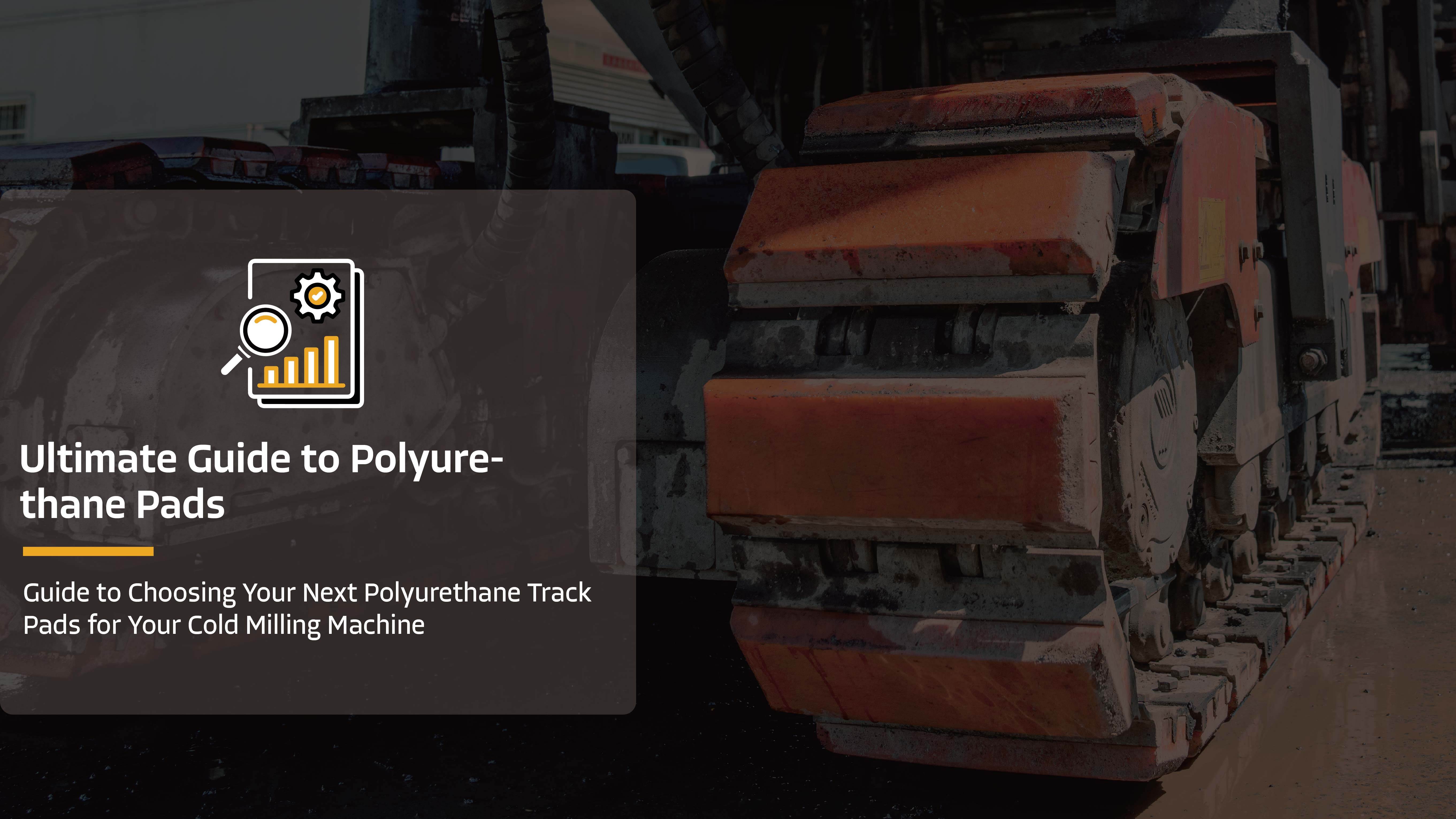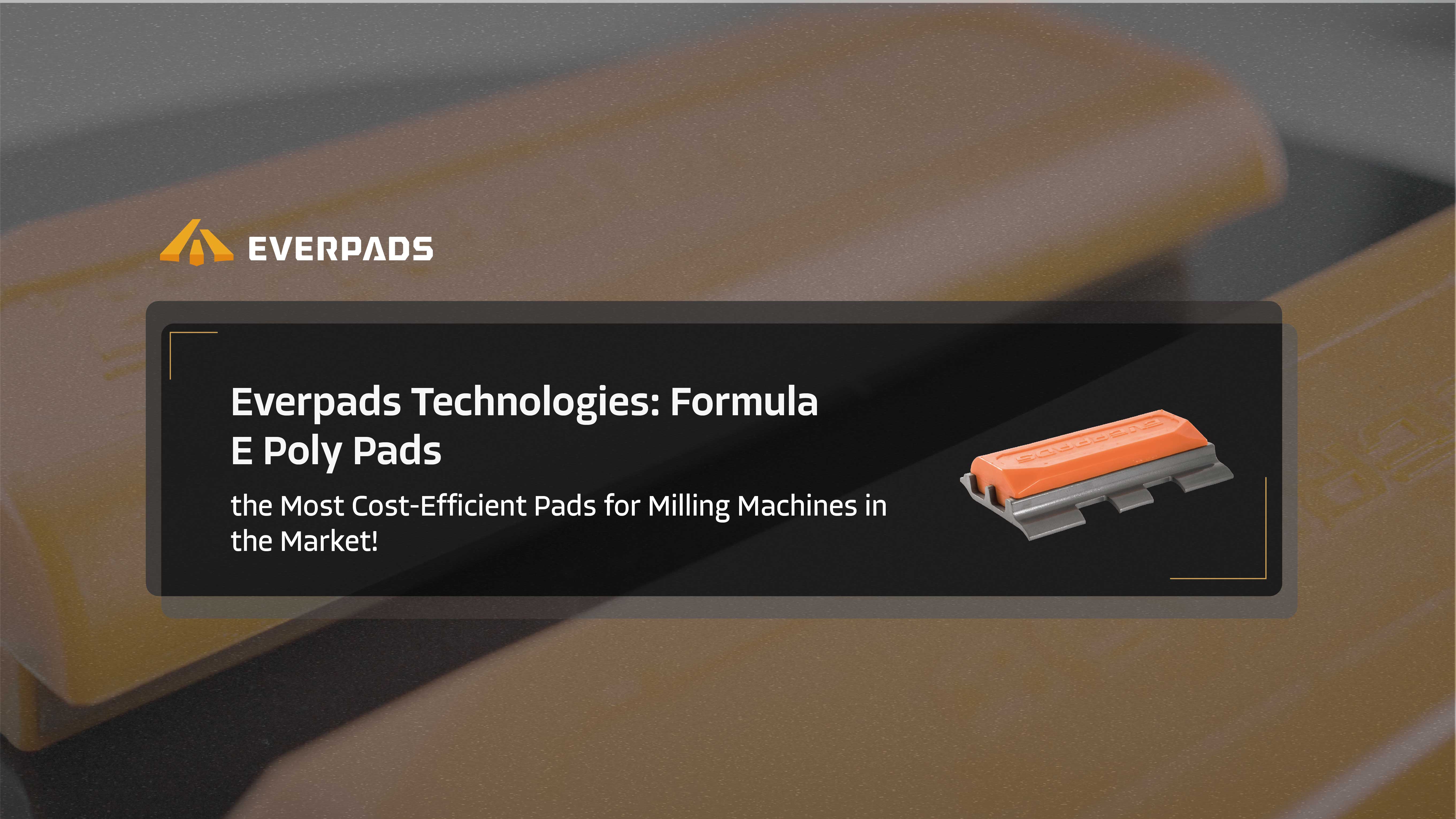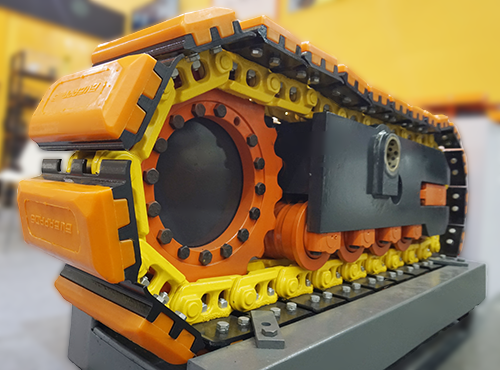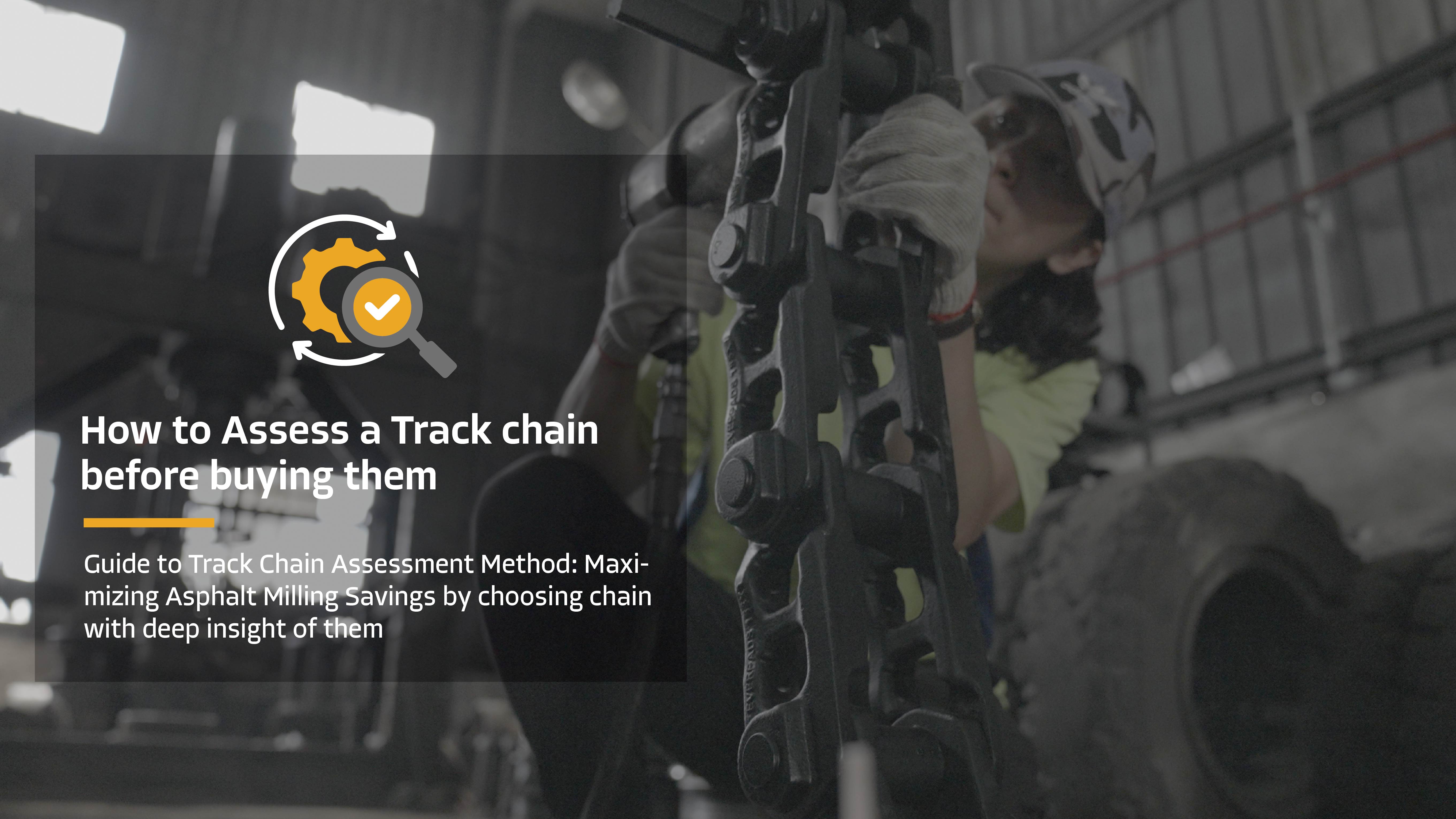Choosing the right polyurethane track pads for your Cold Milling Machine / asphalt planerscan significantly impact your operational efficiency, cost savings, and overall machine performance. With numerous options available in the market, making an informed decision is crucial for maximizing the lifespan of your equipment and ensuring optimal functionality in various milling conditions.
In this guide, we will walk you through the essential factors to consider when selecting polyurethane track pads for your cold milling machine. From understanding the benefits of polyurethane material to evaluating specific product features and compatibility, we aim to provide you with comprehensive insights that will help you make the best choice for your needs. Whether you're a seasoned contractor or new to the industry, this guide will equip you with the knowledge to enhance your milling operations and achieve superior results.
Let's dive in and explore how to choose the perfect track pads for your cold milling machine!
Purpose of this Blog:
- Provide knowledge and tools for assessing aftermarket polyurethane pads.
- Aim to reduce maintenance expenses in asphalt milling.
- Link to an additional guide on pad replacement.
Who Will Benefit:
- Contrators looking for a better poly pad solution.
- Contractors aiming for better asphalt milling performance and efficiency.
- Contractors looking to reduce the operational cost of asphalt milling.
Table of Contents:
1. Risks of Using Inferior Poly Pads
2. Basic Consideration Indicators to Compare Poly Pads
3. Challenges for Poly Pads to Address Each Indicator
4. How to Assess Whether a Poly Pad Addresses the Challenges Well
5. How to Evaluate a Manufacturer's Capabilities in Poly Pad Production
6. Taking the Next Steps
I. Risks of Using Inferior Poly Pads
_6.12%E9%83%A8%E8%90%BD%E6%A0%BC_%5BBlog%5D%20May%20W1-2.png?width=6917&height=1349&name=(%E4%BA%8C%E7%A8%BF)_6.12%E9%83%A8%E8%90%BD%E6%A0%BC_%5BBlog%5D%20May%20W1-2.png)
Using low-quality poly pads can lead to a range of issues, including premature failure, increased wear on machinery, and poor performance results on the asphalt surface. These risks can significantly impact the efficiency and cost-effectiveness of your asphalt milling operations.
- Increased Unexpected Downtime: Low-quality pads often fail prematurely, causing unexpected downtime and disrupting your project schedule.
- Higher Replacement Requirements and Direct Pad Expenses: Frequent replacements of low-quality pads lead to increased direct expenses and maintenance costs.60
- Reduced Lifespan of Whole Machine: The unstable traction support from low-quality pads can shorten the overall lifespan of your milling machines.
- Reduced Lifespan of Undercarriage System Parts: Other parts of the undercarriage system also suffer from the increased strain and wear caused by low-quality pads, leading to more frequent repairs and replacements.
These consequences are avoidable after understanding the principle of track pads, giving you the power to make informed decisions in the future on this topic.
II. Why Selecting Poly Pads is so important
_6.12%E9%83%A8%E8%90%BD%E6%A0%BC_%5BBlog%5D%20May%20W1-3-1.png?width=2937&height=1270&name=(%E4%BA%8C%E7%A8%BF)_6.12%E9%83%A8%E8%90%BD%E6%A0%BC_%5BBlog%5D%20May%20W1-3-1.png)
There are six attributes to assess poly pads: resilience strength, compressive strength, low heat penetration coefficient, cut resistance, abrasion resistance, and track pad design.
Main Interactions:
Longevity- Abrasion Resistance: Evaluates the material's ability to withstand wear and tear due to friction and contact with abrasive surfaces.
- Low Heat Penetration Coefficient: Slow heat penetration ensures the pads do not overheat quickly, which is crucial for maintaining performance and longevity during prolonged use.
- Compressive Strength: The capacity of the poly pads to withstand loads tending to reduce their size, ensuring durability under constant pressure from machinery.
Premature Failure Resistance
- Cut Resistance: The design should provide excellent resistance to cuts and abrasions, ensuring the pads remain intact and effective even in harsh working conditions.
- Resilience Strength: The ability of the poly pads to absorb and recover from heavy impacts and stress without permanent deformation.
Operation Performance
- Cut Resistance: Enhanced cut resistance ensures the pads maintain their integrity and performance in harsh conditions.
- Design of Track Pads: The overall design should optimize the distribution of force and provide stability, reducing wear and tear on both the pads and the machinery.
- Traction Support: Milling machines require stable and significant traction support to move forward while the milling teeth cut the surface, delivering a quality milling result.
In practical applications, these indicators separately and sometimes interactively affect the longevity, premature failure resistance, and operation performance of poly pads in asphalt milling operations.
III. Challenges for Poly Pads to Address Each Indicator
High-quality poly pads must address multiple performance indicators, each presenting unique challenges. Ensuring durability, consistent load-bearing capacity, and abrasion resistance requires the use of superior materials and advanced manufacturing processes. Here's a detailed look at why these challenges are difficult to address:
Challenge #1: Abrasion & Cut Resistance
Issue: Asphalt cold planers often operate on curbs or milled road surfaces, which erodes the surface of poly track pads. Without high wear and tear resistance, poly compounds cannot withstand the abrasive action of curbs and asphalt particles under heavy loads, leading to partial exfoliation and premature failure._6.12%E9%83%A8%E8%90%BD%E6%A0%BC_%5BBlog%5D%20May%20W1-4.png?width=5439&height=2007&name=(%E4%BA%8C%E7%A8%BF)_6.12%E9%83%A8%E8%90%BD%E6%A0%BC_%5BBlog%5D%20May%20W1-4.png)
Why It's Hard to Address:
2. Consistent Performance: Ensuring that every batch of poly pads maintains the same high standard of abrasion resistance requires rigorous quality control and precise manufacturing processes.
Solution: Proper Poly Compound
- Premium Material: Use high-quality polyurethane with low ionization energy, great heat tolerance, and compressive strength.
- Enhanced Properties: Seek compounds offering superior heat tolerance, wear resistance, tear resistance, and compressive strength.
Benefits:
- Resilience strength
- Compressive strength
- Low heat penetration coefficients
- Cut resistance
- Abrasion resistance
Challenge #2: Traction Capabilities
Issue: Milling machines need traction to stay stable during the cutting process. Poor traction leads to unstable movement, negatively impacting operational performance._6.12%E9%83%A8%E8%90%BD%E6%A0%BC_%5BBlog%5D%20May%20W1-5.png?width=5446&height=2007&name=(%E4%BA%8C%E7%A8%BF)_6.12%E9%83%A8%E8%90%BD%E6%A0%BC_%5BBlog%5D%20May%20W1-5.png)
Why It's Hard to Address:
1. Chemical Composition: Improving traction requires complex chemical modifications to the polyurethane, which can compromise other properties like flexibility or durability.2. Operational Consistency: Maintaining improved traction in diverse conditions (wet, dry, cold, hot) adds another layer of complexity to the design and formulation of the poly pads.
Solution: Special Traction Poly Formula
- Innovative Formula: Incorporate a special chemical formula to enhance the traction ability of polyurethane.
- Improved Stability: This ensures the milling machine's stability, providing a better operational experience and consistent performance during pavement removal.
Challenge #3: Weight Load Strength
Issue: Milling machines, weighing up to 49 tons, require poly track pads that can withstand heavy loads to prevent abnormal bending and curves._6.12%E9%83%A8%E8%90%BD%E6%A0%BC_%5BBlog%5D%20May%20W1-6.png?width=5446&height=2007&name=(%E4%BA%8C%E7%A8%BF)_6.12%E9%83%A8%E8%90%BD%E6%A0%BC_%5BBlog%5D%20May%20W1-6.png)
Why It's Hard to Address:
1. Load Distribution: Designing poly pads that distribute weight evenly to avoid localized stress points is complex and requires precise engineering.2. Structural Integrity: Ensuring the poly pads maintain their shape and strength under continuous heavy loads without deforming is difficult, especially over extended periods.
Solution: Proprietary Support Frame and Built-In Steel Plate
- Engineered Structure: Use a built-in plate combined with a patented support frame to significantly enhance the adhesive force and strength of the poly track pads.
- Durability: This design prevents unexpected breakage, ensuring reliable performance even on uneven and rugged road surfaces.
IV. How to Assess Whether a Poly Pad Addresses the Challenges Well
Using the provided test report information as a standard, here's how to assess whether a poly pad addresses the necessary performance indicators effectively:
Longevity_6.12%E9%83%A8%E8%90%BD%E6%A0%BC_%5BBlog%5D%20May%20W1-7.png?width=5446&height=2007&name=(%E4%BA%8C%E7%A8%BF)_6.12%E9%83%A8%E8%90%BD%E6%A0%BC_%5BBlog%5D%20May%20W1-7.png)
Key Indicators to Assess:
1. Low Heat Penetration Coefficient:
- Heat Tolerance: Assess the material’s ability to withstand high temperatures without degrading.
- Heat Penetration Coefficient: Ensure the material has a low heat penetration coefficient to prevent overheating during extended use.
- Hardness of the track pads: Request the testing data to ensure that the track pads' hardness is around 92 HRC.
Key Questions:
- Q1: Does the material exhibit high heat tolerance and low heat penetration, ensuring it remains stable under prolonged use?
- Q2: Are there documented results showing the material’s performance in high-temperature environments?
- Q3: What is the specific hardness rating of the track pads, and how does it compare to industry standards?
2. Abrasion Resistance:
- Abrasion Resistance (ISO 4649:2017 Method A): Evaluates how much material is lost due to abrasion. The test report shows a relative volume loss of 29.0 mm³. Lower values indicate better abrasion resistance.
Key Questions:
- Q4: Is the abrasion resistance (e.g., 29.0 mm³) low enough to ensure durability in harsh conditions?
3. Compressive Strength:
- Load-Bearing Capacity: Ensure the pad can support the maximum load of the milling machine without deforming.
- Structural Design: Review the design features, such as built-in plates and support frames, that enhance the pad's strength and adhesive force.
Key Questions:
- Q5: Can the pad withstand the heavy loads of milling machines, up to 42 tons, without abnormal bending or curves?
Premature Failure Resistance_6.12%E9%83%A8%E8%90%BD%E6%A0%BC_%5BBlog%5D%20May%20W1-8.png?width=5446&height=2007&name=(%E4%BA%8C%E7%A8%BF)_6.12%E9%83%A8%E8%90%BD%E6%A0%BC_%5BBlog%5D%20May%20W1-8.png)
Key Indicators to Assess:
1. Cut Resistance:
- Shore Hardness (ISO 868:2003): A measure of the hardness of the material. For instance, the report shows a result of A/15: 96. Higher values indicate a harder and potentially more wear-resistant material.
Key Questions:
- Q1: Does the Shore hardness meet or exceed the standard value (e.g., A/15: 96) for high abrasion resistance?
2. Resilience Strength:
- Impact Resistance: Ensure the pad can absorb and recover from heavy impacts without permanent deformation.
- Tear Strength (ISO 34-1:2015 Method B): Indicates the material's resistance to tearing. The test report result is 149 kN/m, which is a strong indicator of good tear resistance.
Key Questions:
- Q2: Does the material show high resilience strength to prevent early damage and reduce the likelihood of premature failure?
- Q3: Is the tear strength value (e.g., 149 kN/m) sufficient to resist tearing under operational stresses?
Operation Performance![(二稿)_6.12部落格_[Blog] May W1-9](https://www.everpads.com/hs-fs/hubfs/(%E4%BA%8C%E7%A8%BF)_6.12%E9%83%A8%E8%90%BD%E6%A0%BC_%5BBlog%5D%20May%20W1-9.png?width=5446&height=2007&name=(%E4%BA%8C%E7%A8%BF)_6.12%E9%83%A8%E8%90%BD%E6%A0%BC_%5BBlog%5D%20May%20W1-9.png) Key Indicators to Assess:
Key Indicators to Assess:
1. Cut Resistance:
- Shore Hardness (ISO 868:2003): A measure of the hardness of the material. For instance, the report shows a result of A/15: 96. Higher values indicate a harder and potentially more wear-resistant material.
Key Questions:
- Q1: Does the Shore hardness meet or exceed the standard value (e.g., A/15: 96) for high abrasion resistance?
2. Design of Track Pads:
- Traction Capabilities: Look for details on any special chemical formulas used to enhance traction.
- Field Performance: Check if the poly pads have documented field performance results demonstrating improved traction and stability.
Key Questions:
- Q2: Does the pad incorporate a special chemical formula to enhance traction?
- Q3: Are there performance test results or user feedback indicating improved stability and traction during operation?
3. Traction Support:
- Traction Efficiency: Evaluate the poly pads' ability to provide stable and significant traction support to move forward while the milling teeth cut the surface.
Key Questions:
- Q4: Does the pad provide the necessary traction support to ensure smooth and efficient milling operations?
V. How to Evaluate a Manufacturer's Capabilities in Poly Pad Production
Evaluate a manufacturer’s capabilities by examining their R&D and design experience, engineering and manufacturing precision, innovative wear-resistant solutions, rigorous quality control measures, and investment in technology and workforce training. These factors are indicative of a manufacturer’s ability to produce high-quality poly pads.
Steps to Evaluate Manufacturer's Capabilities:
- Material Quality and Sourcing: Check the specifications and reliability of the materials used.
- Production Processes: Assess the technology, equipment, and process control in the manufacturing process.
- Testing and Quality Assurance: Ensure adherence to international testing standards and robust quality assurance programs.
- Experience and Expertise: Evaluate the manufacturer’s experience and technical expertise in producing poly pads.
- Customer Feedback and References: Look for testimonials, case studies, and references from existing customers.
- Innovation and R&D: Assess the manufacturer’s commitment to research, development, and continuous improvement their compounds of pads.
VI. Taking the Next Steps
Assess Your Own Pads: Evaluate your current poly pads against the key performance indicators, including abrasion and cut resistance, traction capabilities, weight load strength, and heat penetration coefficient. If you're unsure whether your poly pads need replacement, [read this blog] for a detailed replacement check method.
Contact Everpads Expert: For a comprehensive evaluation and expert guidance, reach out to Everpads. Our experts are ready to assist you with detailed assessments, recommendations for high-quality poly pads, and insights into the latest innovations.
Get Started Today!
Ensure optimal performance and longevity in your asphalt milling operations with Everpads!
Article you might like:
What are milling machines?
Cold milling machines are indispensable in the pavement milling process(Cold Planing), playing a crucial role in removing and grinding the existing surface. At the heart of these machines is the rotating milling drum, equipped with rows of metal cutting teeth. This drum rotates in the opposite direction of the machine’s movement, effectively cutting into the pavement with objective milling depth. The milling width is determine by the machine model. The speed of rotation is relatively low, which helps in managing the wear and tear on the cutting teeth. These teeth are subject to significant stress and need regular replacement, with intervals varying based on the milling material, ranging from hours to days. Additionally, Micro milling is a specialized technique for maintaining road surfaces. Using reclaimed asphalt pavement (RAP) in the context of recycling old asphalt can enhance the durability and longevity of the pavement, while also providing environmental benefits by reducing waste and costs associated with new asphalt.
The milling drum is a pivotal component, enabling efficient removal of pavement layers. For more precise removal, fine milling drums are employed, which significantly improve the quality of the road surface. The drum is enclosed in a housing or scraper that contains the milled material, which is then collected and deposited onto a conveyor. To manage the heat generated during the milling process and to control dust, water is typically applied to the drum as it spins. This not only cools the drum but also helps in maintaining a cleaner work environment....
Learn more: Asphalt Cold Milling Machine: A Powerful Tool for Road Construction and Repair
.png?width=698&height=417&name=%E5%AE%98%E7%B6%B2logo%20(1).png)






